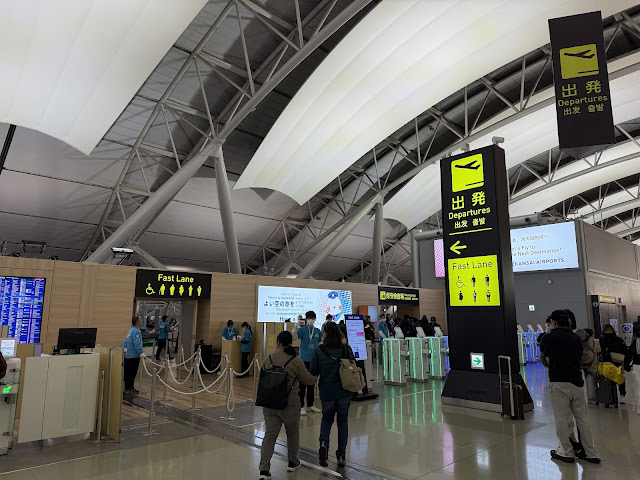腳下是土地,但也是漂浮於潮汐之間,倚著787機上的舷窗,欣賞這座填海造陸的代表機場。
從空橋後推,飛機在跑道滑行、等待、起飛,這是科技從陸地延伸拓展到廣闊的大海與藍天。
BR129是長榮一天三班大阪返回台北的最後一班,晚上六點起飛,旅客正常來說會是最多。
Kansai International Airport, built on reclaimed land, offers stunning views through its expansive windows, whether from the terminal corridors or ANA lounge. As my 787-10 pushed back, taxied, and took off into the evening sky, it felt like a seamless extension of technology from land to sea and air. BR129, departing at 6 PM, is EVA Air’s last Osaka-to-Taipei flight of the day.
填海造陸的關西機場,結合大片落地窗,無論是機場大廳或長榮配合的貴賓室,風景都很好。
長榮、星宇、華航在關西機場用的都是第一航廈,商務艙旅客能在報到時拿快速通關券,
安檢出關就快得多,可惜高卡會員搭經濟艙就沒有這項福利,稍微有別一般的快速通關。
EVA Air, Starlux, and China Airlines all operate from Kansai’s Terminal 1. Business class passengers receive a fast-track pass for security, speeding up the process, though elite membership travelers don’t get this perk when taking economy class.
這天搭的是機齡5年的B-17805,787-10的硬體對於2個半小時的區域航線已是相當足夠。
能180度躺平與1-2-1的獨立座位配置,加上國籍航空在硬體保養都有用心,沒什麼好挑剔。
台北大阪這條航線價格競爭激烈,不含外籍航空,長榮、華航、星宇都有直飛,旅遊買票時,
能多留意機型。畢竟不同機型的商務艙硬體設計不同,飛機的新舊也會與體驗有很大關係。
像是華航A330-300的座椅設計傳統又老舊;星宇最新穎,只是擔心機隊不足的調度問題。
Tonight’s aircraft, the five-year-old B-17805, offered a solid experience for the short 2.5-hour regional route. The 1-2-1 configured, fully flat seats were well-maintained, as expected from a full-service airline. On this competitive Taipei–Osaka route, seat comfort varies by airline and aircraft type. China Airlines’ A330-300 seats feel outdated, while Starlux’s are the newest, though their limited fleet can sometimes lead to scheduling concerns.
787商務艙共3間廁所,右後方的空間最大,加上幾次驗證,資深空姐多優先服務左側後方。
選位時座位都還有空,我基本上會選右側中段,自己是覺得,服務、溝通和親和力會比較好。
另外想睡覺或不習慣戴耳機,也不建議選第一排,787廚房在機頭,備餐或聊天聲非常吵。
長榮的Thompson Vantage XL商務艙是交錯配置,沒有拉門,只有在扶手處有一片拉動隔板,
喜歡隱密性的人可以留意選位圖,選人在內側靠窗、外側是扶手的位置,而不是人在外側的。
化妝室有附洗手乳、乳液、香氛噴霧,保濕噴霧有或沒有始終搞不懂,或許只有787-9才有。
The 787 business class cabin has three toilets, with the most spacious one at the rear right. Toilets are stocked with hand soap, lotion, and fragrance spray, though the availability of facial mist seems inconsistent. Observing multiple flights, I’ve noticed senior flight attendants tend to prioritize service in the left rear section, so I usually pick a mid-right seat for better interaction. The first row isn’t ideal for light sleepers, as the galley noise can be disruptive. EVA Air’s business class seats have a staggered layout without sliding doors—only a small privacy divider. For those who value privacy, I recommend selecting a seat where the passenger is closer to the window rather than the aisle.
Menu
日式炙烤鹽麴牛排 梅香紫蘇飯、地瓜羊羹、FormoCHA清香清茶、獺祭純米大吟釀45
我想延伸在日本的旅遊體驗,就吃日式餐吧。另外兩個主餐是雞肉漢堡排/多蜜醬/里昂洋芋、
鼎泰豐紅燒牛肉麵。懷石料理的小菜多,網路選餐只有顯示主菜和主食,沒像星宇有圖片,
實際內容物得登機後看菜單才知道。全熟的鹽麴牛排,不至於乾柴,但也沒到鮮嫩,
餐具只有筷子,所以得要和牙齒、上下顎、頭部搭配,轉頭一撕扯斷,是略帶鹹味的調味。
一旁的前菜、先付、小缽,我認為都較主菜來的精彩或特色。梅香紫蘇飯雖說風味挺好,
但如果來回航班只能選一餐吃日式料理,建議選在台北出發的航段。記得前次搭的BR132,
中村元計的紫蘇飯,透過米飯蒸氣加熱後的簡單草本清香,混著米飯同吃,我是非常喜歡。
Wanting to extend my Japanese travel experience, I opted for the Japanese meal. The steak, cooked well-done, wasn’t dry but lacked tenderness, and eating it with only chopsticks required some effort. Surprisingly, the appetizers stood out more than the main dish. While the perilla rice had a pleasant herbal aroma, if you’re choosing only one Japanese meal on a round-trip flight, I’d recommend selecting it on the Taipei-bound leg.
長榮這幾年感覺成本節約的明顯,在機上的餐食準備數量、質量、酒單上都能讓乘客有感。
幾杯黃湯下肚,在降落前小睡片刻,醒來發現椅背沒豎直,和以往空姐會巡視的經驗不一樣。
希望規定有調整成椅背不用豎直,要否飛安檢查沒落實,也讓人有點擔心從安全性開始省了。
EVA Air’s cost reduction have become noticeable in meal quantity, quality, and even the wine list. After a few drinks, I dozed off, only to wake up and find my seat back still slightly reclined—something flight attendants previously checked before landing. Whether this is a new policy or a lapse in safety checks, it’s a bit concerning.
**延伸閱讀**






























